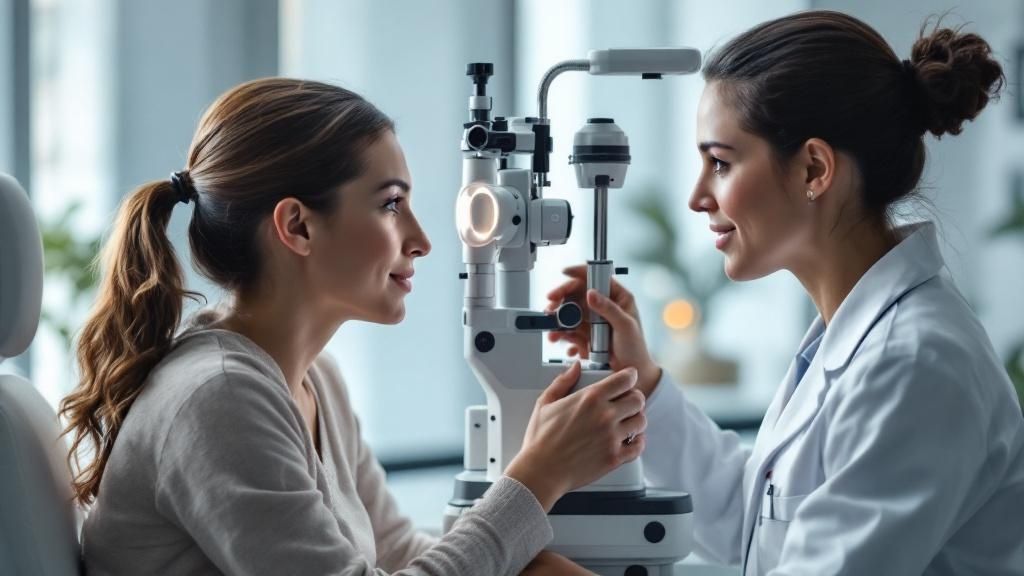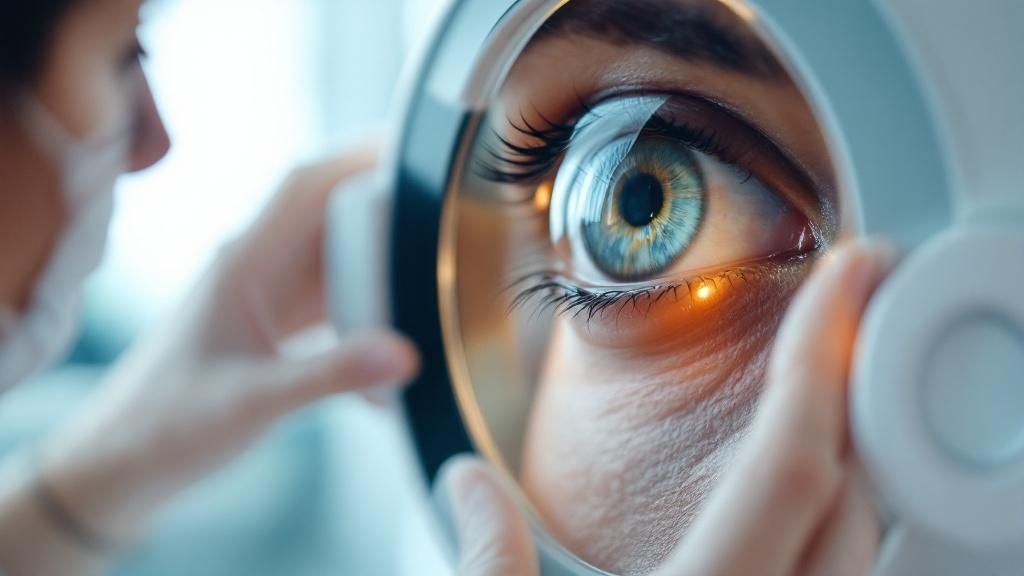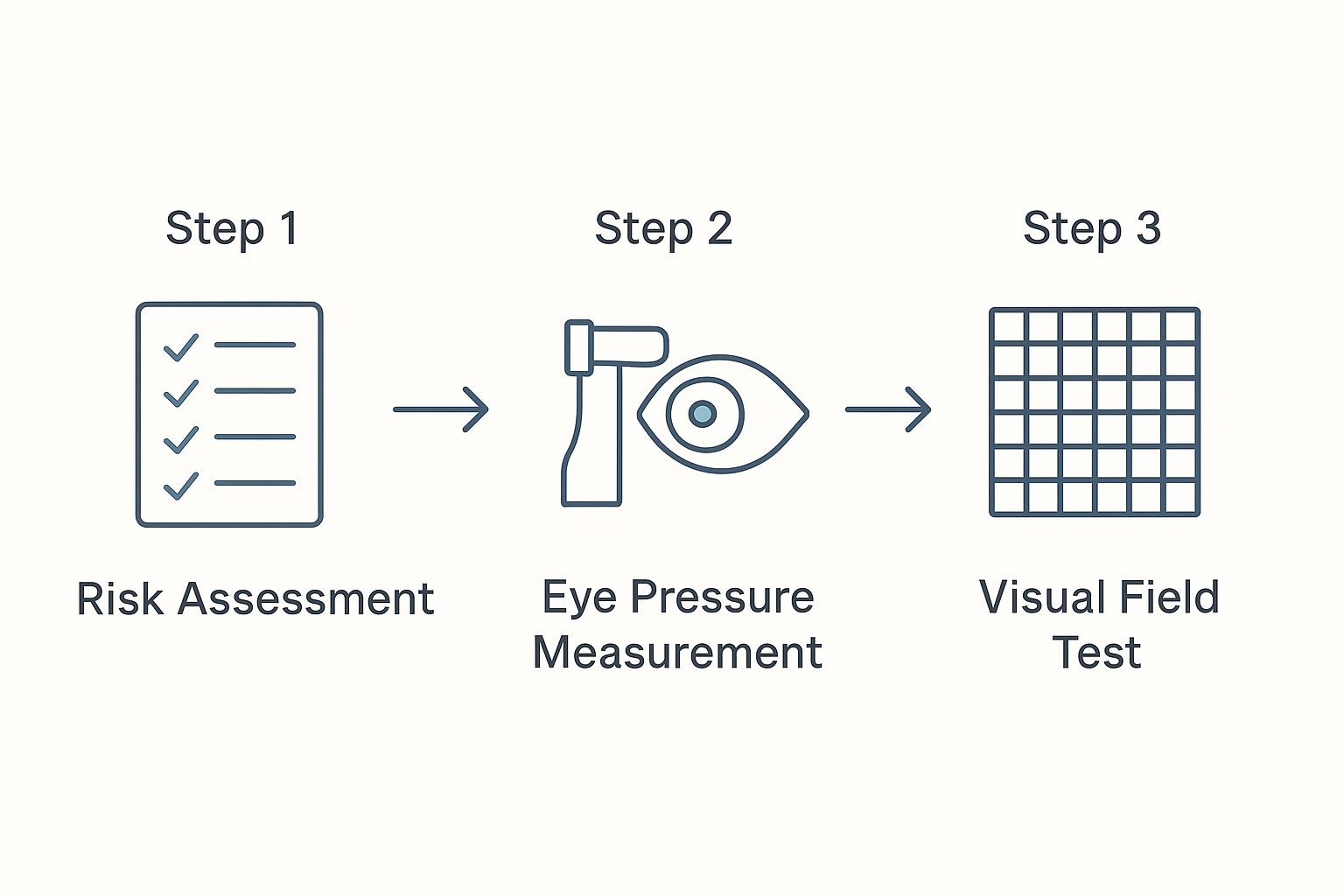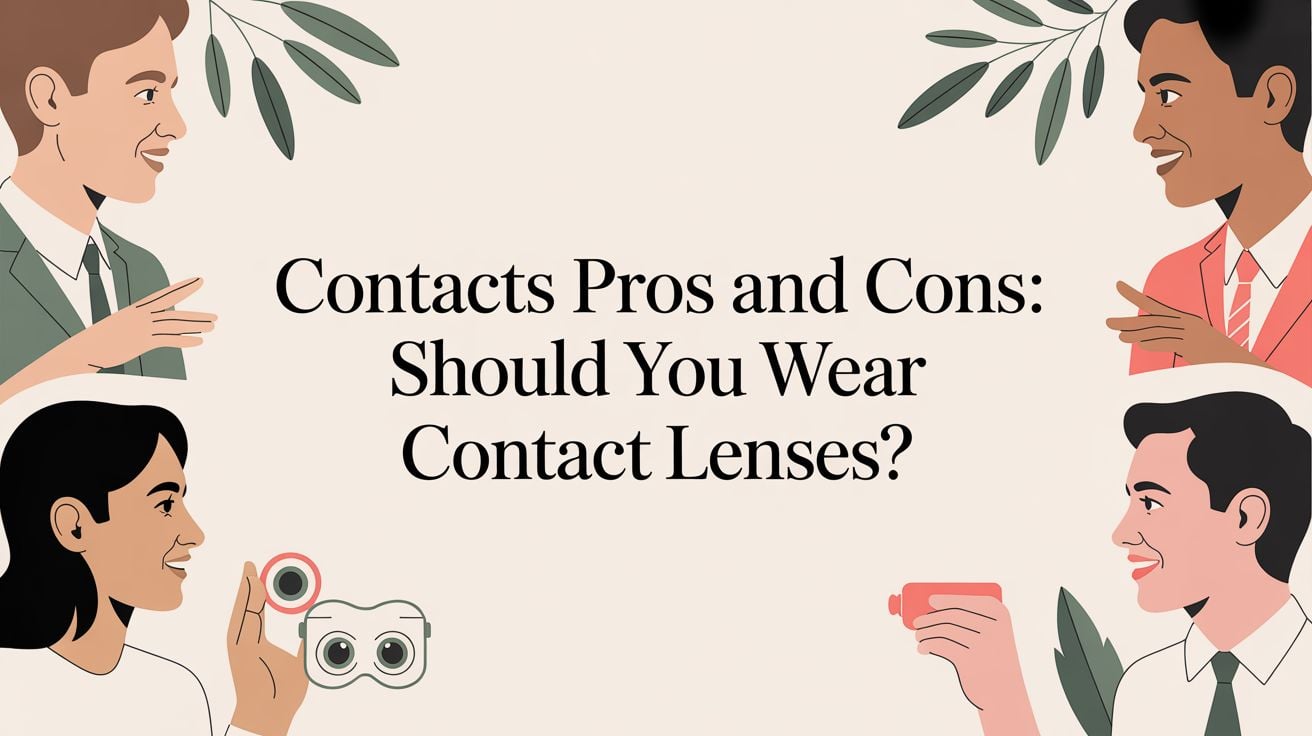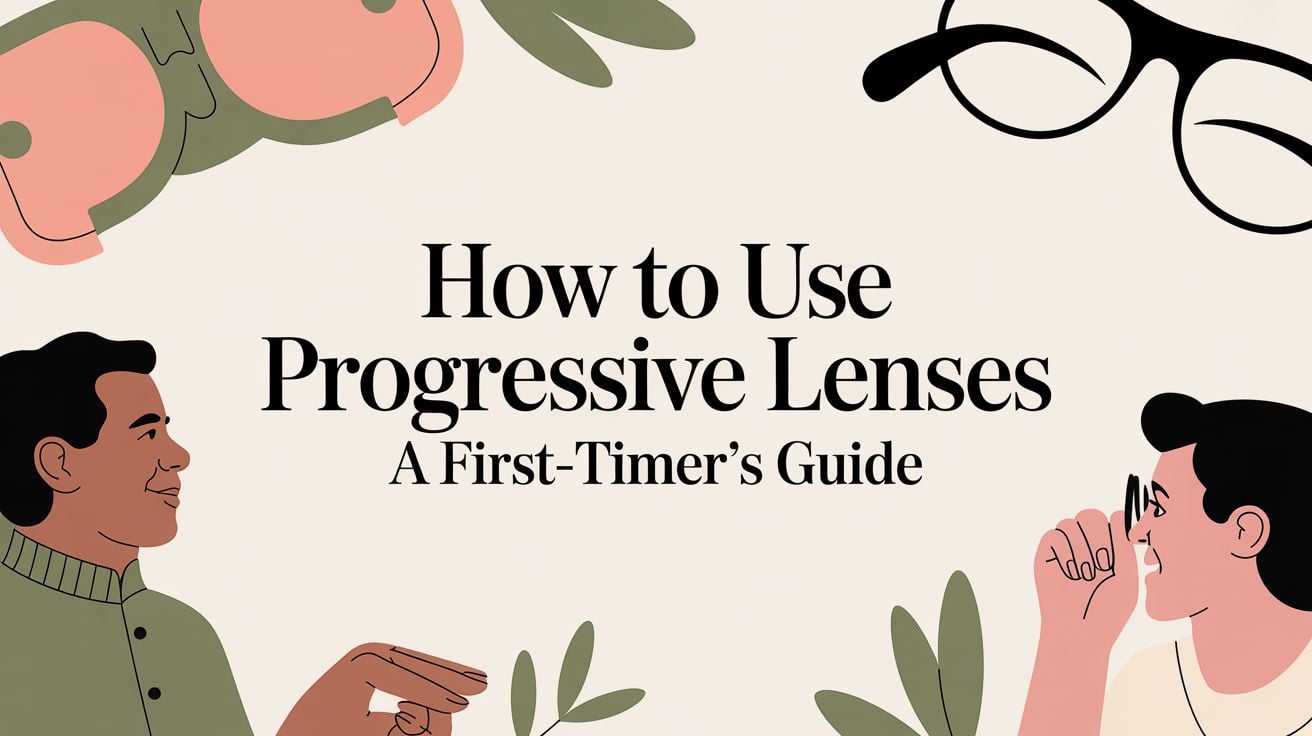Glaucoma has a well-earned, and rather frightening, nickname: the "silent thief of sight." It gets this name because it can quietly damage your vision for years without a single warning sign. So, what exactly is a glaucoma screening? It’s simply a series of painless, routine tests your eye doctor uses to look for the earliest clues of the disease, long before you would ever notice a problem yourself. For residents of Glendale Heights, staying proactive with your eye health is one of the best investments you can make.
Think of it as an essential safety inspection for your eyes.
Why Glaucoma Screening Is a Non-Negotiable Part of Your Health
Here in Glendale Heights, where we all care about staying healthy, being proactive with eye care is just common sense. A glaucoma screening isn't an isolated procedure; it's a vital component of your detailed eye exams in Glendale Heights, designed to protect your sight. The entire point is to catch glaucoma in its earliest, most manageable stages.
At its core, a screening boils down to two critical measurements:
- Optic Nerve Health: We carefully assess the condition of the nerve that acts as the data cable between your eye and your brain.
- Intraocular Pressure (IOP): This test measures the fluid pressure inside your eye. While not the only factor, high pressure is a major risk for glaucoma-related damage.
The "Silent" Threat to Your Vision
The reason we emphasize screening so much is simple: glaucoma usually has no symptoms until significant, permanent vision loss has already happened. You won't feel any pain. Your central, reading vision will seem perfectly fine in the beginning. The disease works by slowly chipping away at your peripheral (side) vision, a process so subtle that your brain often compensates, and you don't realize what you've lost until it's too late.
A glaucoma screening is the only reliable way to catch this disease before it causes irreversible damage. It's a proactive step that gives you the power to protect your vision for life.
At iDoctor, we’re proud to serve patients from all over the Chicagoland area—whether you're driving down North Avenue from Carol Stream or just around the corner in Bloomingdale. We believe everyone deserves clarity, both in what they see and in understanding their health. Our advanced imaging gives us an incredibly detailed picture of your eye's health, allowing us to detect even the faintest signs of a potential problem.
More Than Just a Pressure Check
Many people mistakenly think the glaucoma test is just that quick "air puff" they get at an eye exam. While that's one small part, a comprehensive screening is so much more. It's a careful evaluation that considers your personal risk factors, takes precise measurements of your eye's internal structures, and includes a thorough examination of your optic nerve.
For our neighbors in Glendale Heights, this means having the best possible defense against preventable vision loss.
Understanding Glaucoma and Its Threat to Your Vision
Before we can appreciate just how vital glaucoma screening is, we need a clear picture of what the disease actually does. A great way to visualize your eye is to think of it like a delicate, self-inflating balloon. It needs to maintain a very specific internal pressure to hold its shape and work correctly.
This internal pressure is known as intraocular pressure (IOP). It’s maintained by a clear fluid that your eye continuously produces and drains. In a healthy eye, this is a perfect balancing act—the fluid drains away at the same rate it’s created, keeping the pressure stable and safe.
The Optic Nerve: Your Eye’s Lifeline to the Brain
Glaucoma throws this delicate system out of balance. Think of it like a sink with a slowly clogging drain. The fluid can’t exit properly, so it starts to build up, causing the pressure inside your eye to climb. This increased pressure puts immense strain on your optic nerve, the crucial bundle of fibers that acts as the communication cable between your eye and your brain.
Your optic nerve is an incredible structure, made up of over a million tiny nerve fibers that carry visual information. When high IOP starts to damage these fibers, they gradually die off. This creates permanent blind spots in your field of vision.
The truly insidious part of glaucoma is how it begins. It typically starts by chipping away at your peripheral (side) vision. Because this loss is so gradual and starts at the edges, your brain is surprisingly good at compensating for the missing information. You often don't notice a problem until a significant amount of irreversible damage has already been done. It's for this very reason that glaucoma has earned its ominous nickname: the "silent thief of sight."
Because glaucoma develops without symptoms, early and regular screening is your only real defense. By the time you notice vision changes, the damage is already done and cannot be undone.
Glaucoma On a Global Scale
This silent threat is far from a rare condition; it's a major public health concern around the world. The prevalence of glaucoma is estimated to be 3.54% for individuals between the ages of 40 and 80.
Globally, the number of people living with glaucoma is expected to jump from 76 million in 2020 to a startling 111.8 million by 2040. Certain factors, like your ancestry and family history, also play a big role in your personal risk. For a deeper dive into these trends, you can explore the full research on glaucoma prevalence.
Catching the earliest signs of trouble, long before they ever lead to noticeable vision loss, is the entire goal of modern eye care. To learn more, we highly recommend reading our detailed post on the importance of early detection for glaucoma. For our neighbors in Glendale Heights, being proactive with regular screenings is the single most effective way to protect your vision for a lifetime.
Who Is at High Risk for Glaucoma?
While glaucoma can technically happen to anyone, it doesn't affect everyone equally. Certain factors can dramatically increase your chances of developing it. Think of these risk factors like warning signs on a busy road—they don't mean an accident is inevitable, but they signal that you need to be more careful.
Knowing if you fall into a high-risk group is the first step toward protecting your eyesight. It helps you and your eye doctor map out a screening schedule that makes sense for you, taking the general question of "what is glaucoma screening?" and making it personal.
Key Risk Factors You Should Know
Some of the most significant risk factors are simply part of who you are and are completely out of your control. This is why awareness and regular check-ups are your best line of defense.
Here are the primary things to be aware of:
- Age: Your risk for glaucoma starts to climb after age 40 and continues to increase with each passing decade.
- Family History: This one is a big deal. If a close relative, like a parent or sibling, has glaucoma, your own risk shoots up considerably. It’s critical information to share with your optometrist.
- Ethnic Background: People of African, Hispanic, or Asian descent are more likely to develop specific types of glaucoma. For example, open-angle glaucoma is more prevalent in those with African heritage, while angle-closure glaucoma is more common in Asian populations.
The global impact of this disease is staggering. Glaucoma is the second leading cause of blindness worldwide, and experts estimate that nearly 80% of the 76 million people affected don't even know they have it. This massive gap highlights the critical importance of screening. Discover more insights about these glaucoma statistics.
Medical Conditions and Other Influences
Beyond your age and genetics, your overall health plays a surprisingly direct role in your eye health. Certain medical conditions can make you more vulnerable to glaucoma.
You'll need more vigilant screening if you have:
- Systemic Health Issues: Chronic conditions like diabetes, high blood pressure, and poor circulation can damage the delicate blood vessels in your eyes, raising your glaucoma risk.
- High Myopia (Nearsightedness): Being significantly nearsighted is another well-established risk factor.
- Previous Eye Injury: A serious trauma to your eye, even an injury that happened years ago, can cause secondary glaucoma to develop down the road.
Your personal risk profile is a unique mix of all these factors. It’s what determines how frequently you should be screened. To get a better feel for what a personalized schedule might involve, you can learn more about how often you should get an eye exam. Here at iDoctor in Glendale Heights, we look at your complete health picture to recommend the right plan for you.
What to Expect During Your Glaucoma Screening
The thought of any medical test can be a little nerve-wracking, but we want to assure you that a glaucoma screening is nothing to worry about. It's a completely painless and essential part of a comprehensive eye exam. Here at iDoctor, we make it a point to walk you through every step, so you feel comfortable and know exactly what’s happening from start to finish.
Think of it this way: a single test can’t tell the whole story. Instead, we gather several key pieces of information that, when combined, give us a crystal-clear picture of your eye health. Our 30-minute detailed eye exams are designed to be incredibly thorough, letting us collect all the necessary data without ever making you feel rushed.
The Tests We Use to Protect Your Vision
When you come in for your screening, our experienced team will conduct a few specific evaluations. Each one is designed to look at a different aspect of your eye's structure and function, which is critical for an accurate and early diagnosis.
To give you a better idea of what we're looking at, here’s a breakdown of the key tests that make up a comprehensive glaucoma screening.
Key Components of a Comprehensive Glaucoma Screening
| Test Name | What It Measures | Why It Matters |
|---|---|---|
| Tonometry | The fluid pressure inside your eye (intraocular pressure or IOP). | High IOP is a major risk factor. We use modern, gentle tonometers—no dreaded "air puff"—to get a precise reading. |
| Visual Field Test | Your complete field of vision, including your peripheral (side) vision. | Glaucoma often affects side vision first. This test helps us find subtle blind spots you might not notice yourself. |
| Optic Nerve Exam | The health, shape, and color of your optic nerve. | This is the most direct way to check for glaucoma damage. We use high-resolution imaging to create a baseline for future comparisons. |
| Pachymetry | The thickness of your cornea (the clear front surface of the eye). | Corneal thickness can affect how we interpret your IOP reading, so this measurement ensures maximum accuracy. |
Each of these tests provides a crucial piece of the puzzle. Together, they allow us to build a complete profile of your eye health and spot any potential signs of glaucoma long before you would notice symptoms.
The image below gives you a simple visual of how we approach the screening process, moving from an initial assessment to the specific diagnostic tests we've just discussed.
As you can see, each step builds on the last, giving us a robust understanding of what's happening inside your eyes.
A Clear and Comfortable Experience
Our number one priority is making your visit as smooth and stress-free as possible. We take our time to explain what we’re doing and, more importantly, why it matters for your long-term vision.
By the time your exam is over, you'll have a solid grasp of your results. To feel even more prepared, you might find it helpful to look over these 5 essential questions to ask your optometrist during an eye exam in Glendale Heights.
We'll discuss everything with you in simple, easy-to-understand terms. At iDoctor, our commitment is to combine advanced diagnostic tools with a genuinely personal touch, ensuring every patient feels confident and well-informed.
How We Interpret Your Screening Results
So, your glaucoma screening is done. You're probably looking at a collection of images and numbers, wondering what it all means. Our job at iDoctor is to cut through the clinical data and give you a straight answer about your eye health. This isn't just about reading a number off a machine; it’s about putting together all the pieces of your personal eye health puzzle.
One of the first pieces we look at is your intraocular pressure, or IOP. People often hear about a "normal" range, but the truth is, what's healthy for your eyes might be too high for someone else's. Eye pressure can also change throughout the day, so a single high reading doesn't automatically mean you have glaucoma. It's just one clue. If you want to dive deeper into this specific test, take a look at our essential eye pressure test guide.
Building Your Personal Baseline
This is where the real value of regular screening shines. Your first comprehensive exam with us here in Glendale Heights sets a vital personal baseline. We capture detailed, high-resolution images of your optic nerve and record all the key measurements.
In every follow-up exam, we'll pull up those original baseline results and compare them directly to what we see today. This direct comparison is incredibly powerful because it helps us spot the tiniest, most subtle changes to your optic nerve or visual field—often the very first signs that glaucoma might be developing.
Think of it like comparing a photo of a coastline from last year to one from today. You can spot the subtle erosion you’d never notice on a day-to-day basis. That's exactly what we're doing with your eyes.
From "Suspect" to Diagnosis
After carefully analyzing everything, we can figure out where you stand. It's important to know that not everyone with a few red flags gets a glaucoma diagnosis on the spot. Many people are classified as a "glaucoma suspect."
This simply means you have one or more risk factors—maybe your eye pressure is a little high or your optic nerve looks slightly different—but there’s no concrete damage yet. If that's the case, we'll map out a monitoring schedule to keep a close watch for any changes over time.
We only make a formal diagnosis when there is clear evidence of optic nerve damage that matches up with changes in your vision. While catching things early is crucial, we are also very careful not to cause unnecessary alarm or start treatment that isn't needed. National guidelines have even been cautious about universal screening, trying to balance the benefits against potential false positives. Since more than 50% of people with glaucoma don't even know they have it, targeted screening for those at higher risk is our best tool for preventing permanent vision loss. You can discover more insights about glaucoma screening challenges on jamanetwork.com.
No matter the outcome, you'll walk out of iDoctor with a complete, clear understanding of your results and what comes next, whether that's simply continued monitoring or discussing a treatment plan.
Your Trusted Glendale Heights Eye Doctor is Here to Protect Your Vision
Your vision is one of your most vital senses, and taking a proactive approach to your eye health is the single best way to preserve it for a lifetime. Think of a glaucoma screening as you would any other essential health check-up—it's a simple, preventative step that can catch potential issues long before they become serious problems. For our neighbors in Glendale Heights, and surrounding towns like Carol Stream and Bloomingdale, this routine care is key.
Here at iDoctor, we pair state-of-the-art diagnostic tools with a genuinely personal touch. Our focus isn't just on running tests; it’s on making sure you walk away with a crystal-clear understanding of your eye health. Whether you're coming from the Glendale Lakes Business Park for a full exam, looking for designer eyeglasses in Glendale Heights from top brands like Cartier and Gucci, or simply need to pick up your contact lenses in Glendale Heights, we're here to help.
We consider your long-term vision our most important responsibility. Taking charge of your eye health with a screening today is a priceless investment in your future.
The iDoctor Experience
The biggest mistake you can make with glaucoma is waiting for symptoms to show up. Because it often develops silently, early and regular screening is your most powerful tool against irreversible vision loss. Come see what makes the iDoctor experience different—where advanced care happens in a comfortable, boutique setting.
Take the first and most critical step in safeguarding your sight. Schedule your detailed eye exams in Glendale Heights with us today. You'll gain the confidence that comes from knowing your vision is being looked after by experts. We’re proud to serve patients from all over the area, including Addison and Lombard, making sure our whole community has access to exceptional eye care.
Local FAQ: Glaucoma Screening in Glendale Heights
Even when you understand the basics of glaucoma screening, it's perfectly normal to have a few more questions pop up. We get it. To help, we've put together some of the most common questions we hear from our patients right here in Glendale Heights, along with clear, straightforward answers.
Is a glaucoma screening painful?
Absolutely not. A proper glaucoma screening is completely painless. The advanced tests we use are either non-contact or involve very gentle instruments.
You might experience a brief, mild stinging sensation if we use eye drops to dilate your pupils—this gives us a better view of your optic nerve—but it fades in just a few seconds. At iDoctor, our team is dedicated to making sure you're comfortable every step of the way.
How often should I get screened?
This is a fantastic question, and the honest answer is: it really depends on your individual risk factors. As a general rule, we suggest most adults get a baseline screening around age 40.
However, if you're in a higher-risk group, we'll want to start monitoring you sooner. These risk factors include:
- Having a family history of glaucoma
- Being of African or Hispanic descent
- Having other health conditions like diabetes
The best optometrist in Glendale Heights won't just follow a generic schedule; they'll create one just for you. That's exactly what we do at iDoctor. This personalized approach is a cornerstone of our practice, something we talk more about in our article on the importance of routine eye exams.
Key Takeaway: A personalized screening schedule is far more effective than a one-size-fits-all approach. Your unique health profile determines the right frequency for you.
Does my insurance cover glaucoma screening at iDoctor?
In most cases, yes. Glaucoma screening is considered a standard and essential part of a comprehensive medical eye exam, which is typically covered by both vision and medical insurance plans.
To ensure preventive care is accessible for everyone in our community, iDoctor is proud to accept all major vision insurance plans. Our front-desk team is always ready to help you check your benefits before your visit so there are no surprises.
At iDoctor, we believe clear answers lead to confident decisions about your health. Schedule your exam today at https://idoctoril.com.


